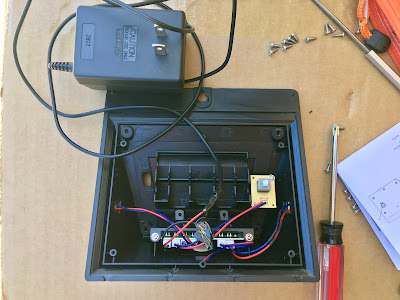I love the solar-powered motion lights I have at my house but recently one started coming on during the daytime, then by night barely had any battery left, so something was definitely not working right.
 |
| Success! Battery-powered light now running from a wall USB charger |
For fun I decided to open it up with my daughter to explore, and found that to my surprise, the inside was delightfully modular! Ripe for hacking. Maybe other models are similar inside? Let me know in the comments, please. I used the MITAOHOH MT-SL-82-4P which comes in a 4-pack for a shockingly low $20-$25.
(In general, it still blows my mind that any company can put products like this together for so cheap -- LEDs, solar panels, batteries, connectors, screws, wires, motion sensor, circuit board, and injection molded housings for $5 each, shipped to my door. Wild. That means negative externalities, unfortunately.)
 |
| Sad, dim solar light on during the daytime where it can't help anyone |
The circuit board has convenient, labeled connectors for the three LED panels, power switch, battery, and solar panel. The PIR motion sensor is built onto the circuit board. Looking around, I realized there is no separate light sensor to determine day/night — it must just get this for free by looking at the voltage of the solar panel!
That means when there is voltage from the solar panel (above some threshold), the light is disabled and it runs in battery-charging mode. Then when solar panel voltage is low, the battery-powered light and motion sensor are enabled.
So with a broken solar panel, I could just remove it and replace the 3.7V LiIon battery with plain-old DC voltage from a wall charger. Turns out it really was that simple.
 |
| Inside of the light as manufactured. Separate connectors for all the components. |
 |
| Modified light -- battery and solar panel removed, wall charger wired to the battery port |
 |
| Comparison of the broken one-year-old solar panel to a brand-new one. I guess the sun can get pretty hot in the Bay Area! |
At first I used an old-school 4.5V wall wart, then decided it would be more fun to run off of USB (5V) so just wired that instead. All it takes is the positive (red) and negative (black) lines from a power supply or cut-open USB cable. I don’t know the optimal voltage/current for these LEDs or circuit board, so I may be reducing their life by using anything higher than 3.7V, but I’m not very concerned about that.
I bet other models of solar-powered LED motion lights are just as modular inside. Have you taken apart any other models? What did you find?
Mike

oh my gosh, Hannah is so cute and big! She is a mini-me of you and Liz!!!!!!
ReplyDelete😄
DeleteTry this useful and amazing products https://amazonproductsbestbuy.blogspot.com/2025/10/top-deals-on-accessories-supplies.html
ReplyDelete